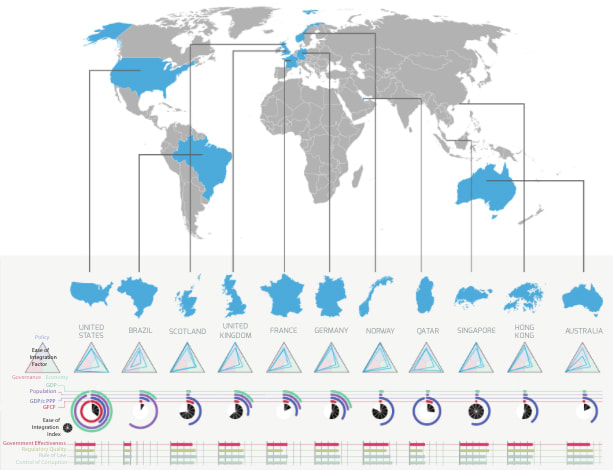dotBuiltEnvironment (dotBE), the rebranded BIM2050 group, has released a report analysing global levels of BIM implementation.
Commissioned by the Scottish Future Trust (SFT) the report aims to gain a better understanding of Scotland’s position in the international area of BIM realisation, and to provide recommendations for both policy and implementation.
The study examines the BIM policy of 12 key countries around the world. It examines a trio of policy, governance and economic factors in these countries to define the effectiveness of BIM implementation and ranks these in a new comparative matrix, named the “Ease of Integration Index” (EOI Index).
The index, which demonstrates the ease in which policy can be executed for a particular country, places Singapore and Norway in first and second place, followed by Scotland and the UK.
Finally, the report examines BIM Level 2 and the current direction of travel that digital policy is taking in the wider international economy.
A key finding of the report is the need to unify the objectives of policy, SMEs and large businesses. The report concludes that it is essential to foster entrepreneurism, maintain continuous development of rigorous Quality Assurance procedures, and develop and invest in effective means of communication of lessons learned and best practice across, and out with, industry.
Henry Fenby-Taylor, BIM implementation manager at WYG and lead author of the report, said, “In preparing this work for SFT we were struck by the lack of international benchmarking opportunities for articulating BIM implementation. In discussion, we developed what we have called the ‘Ease of Integration Index’ (EOI Index), a new matric comparing Policy, Economic and Governance factors, to better explain the development of BIM policy and implementation.


More than ever, industry and policy needs to rise with the tide of innovation and technology and not be dragged out to sea.– Henry Fenby-Taylor
“This has allowed SFT and its contributors to better understand these factors as contributors to successful BIM implementation policy, and to inform its discussions at this exciting juncture for Scotland, as the country’s developing digital construction strategy is resolved.
“What’s important to me is the ‘why’ question. We should always be able to say in plain language what the purpose of our policies are. The EOI matrix and the examples we provide in the report give a basis for informed strategic policy development and decision making. More than ever, industry and policy needs to rise with the tide of innovation and technology and not be dragged out to sea."
David Philp, Chair of the SFT BIM working group, added: “Our construction sector is being reshaped globally by data, digital connectivity and new innovative mind-sets bringing greater opportunities to improve productivity and optimise asset performance. As we develop the SFT BIM guidance we want to ensure that we have given consideration of global best practice associated with the digitisation of the built environment.
“We also want to make sure that we identify, understand and plan for future shifts in technological advancement. The .be report is helping us understand our programme in an international context and what we can do based upon the recommendations to ensure it is appropriate and best in class for a digital Scottish construction landscape both now and in the future.”
Comments
Comments are closed.














Good point: “The export of BIM Level 2 abroad is a key tool in the suite of UK firms seeking to increase their international trade in products and services”.
Obvious findings and recommedations that would not have required a survey and a report. Obviously there is a need for alignment between strategic objectives, large businesses and SMEs. This is a fundamental in business studies. I hope public money is not spent on this work..